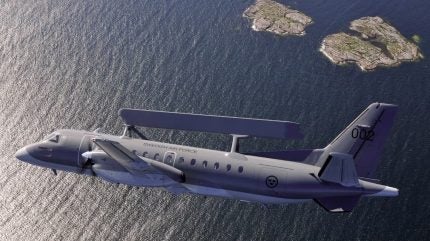
In an escalation of Ukraine defence support, Sweden has pledged two ASC 890 airborne control and surveillance aircraft as part of its 16th and largest military aid package, valued at Skr13.3bn ($1.3bn).
This addition marks advancing Ukraine’s defence capabilities, particularly its ability to detect and manage aerial threats.
James Marques, an aerospace, defence, and security analyst at GlobalData, highlights the importance of this donation. “This is not any type of aircraft Ukraine has used before. They are fitted with huge radars and communications systems, so they’re used to detect aircraft, missiles, other projectiles and sometimes things on the ground and at sea too from very long distances, up to 300-400km away.,” Marques explains.
The ASC 890 is built for airborne early warning and control (AWAC) missions, functioning as airborne command centres. Unlike fighter jets with limited radar range and communication capabilities, these larger aircraft offer surveillance and battlefield management. Marques points out, “ASC Radar then, of course, has far more powerful radar than the F-16’s Ukraine is being given, in one-on-one comparisons with many Russian fighters like SU-35SM, they are still beaten in radar range, meaning they have the important first-shot advantage for their missiles.”
This enhanced surveillance capability is crucial as Ukraine faces intensified Russian airstrikes on both military and civilian targets.
Marques also highlights a crucial aspect: compatibility with Ukraine’s upcoming F-16 fighters. “ASC can send location info to the F-16, which is relayed directly on a screen in the pilot’s cockpit, giving them loads of advantages in choosing when and where to fight,” he notes.
However, Marques raises concerns about the vulnerability of these aircraft. Given their strategic importance, they will become high-priority targets for Russian forces, who have historically developed long-range missiles designed to neutralise such assets. “I do wonder how Ukraine plans to keep these 890s safe,” he muses, emphasising the need for robust protective measures.
According to GlobalData’s “Sweden Defense Market 2023-2028” report, in 2023, the defence budget reached $8.7bn, equating to a yearly increase of 17.3%, clearly demonstrating Sweden’s fiscal response to the invasion of Ukraine.
In addition to the ASC 890 aircraft, Sweden’s military aid includes artillery ammunition, armoured vehicles, and other essential resources to bolster Ukraine’s defence and combat capabilities. This support addresses immediate needs while contributing to the long-term strengthening of Ukraine’s military infrastructure.
Sweden’s decision to donate its entire stock of ASC 890 aircraft and acquire newer GlobalEye planes for its own air force shows a commitment to supporting Ukraine during this juncture. As the conflict continues, these capabilities are expected to play a role in Ukraine’s defence strategy, enhancing its ability to detect, respond to, and counter Russian aggression effectively.








